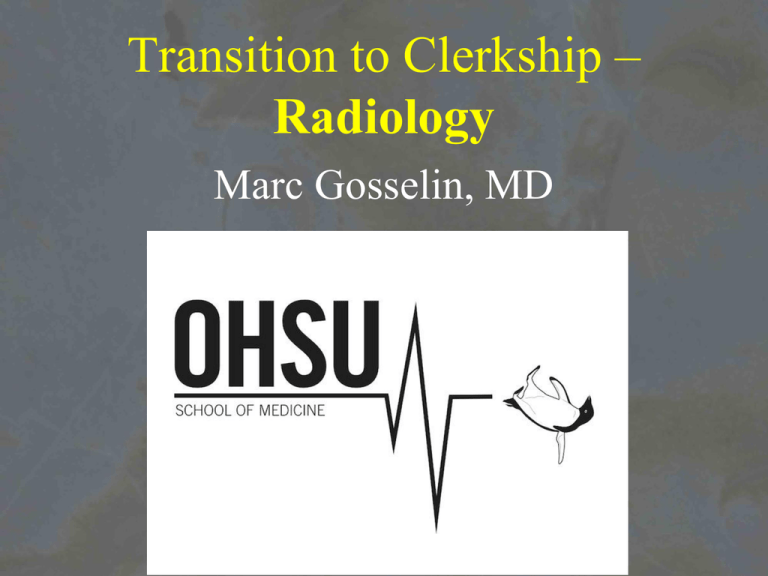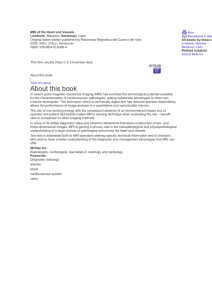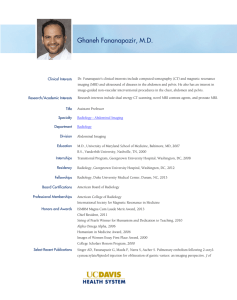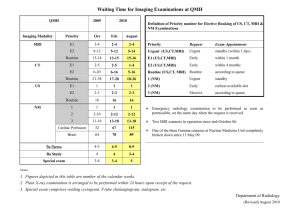Transition to Clerkship – Radiology Marc Gosselin, MD
advertisement

Transition to Clerkship – Radiology Marc Gosselin, MD What Penguins Fell Off The Iceberg Since We Last Meet? Introduction: ‘Medicine is the Science of Uncertainty and the Art of Probability’ – Sir William Osler • Goals Become familiar with and practice using the webPACS system Gain a basic approach to interpreting chest images Gain a basic approach to interpreting bone images Understand the use of the abdominal film Understand the use of contrast Understand practical issues with MRI Key Points Understand the need for clinical information when ordering and interpreting radiological studies Understand how consultation with a radiologist before you order a study can help get the proper study Try to learn about the tests that you are ordering your patient to experience during your rotations. You may never have another chance! BEWARE: The ‘Diamond Algorithm’ is Very Common! Do NOT Be Fooled! Basics for Radiology • • • • Contrast MRI Web sites Images into a presentation Contrast Contrast for x-ray related images is either: Iodinated Barium or Omni for Gastrointestinal tract Contrast for MRI is gadolinium based Some newer experimental agents are iron based. Contrast What it’s used for • • • • Vessels Tumor detection Infection detection Better anatomic detail Contrast- When to order • Brain (1st ? to ask - CT or just order MRI) – Looking for tumor – Infection • Spine – Rarely need – Canal infection (epidural abscess, MRI better choice) – Minimal use in “bone” tumors/mets • Chest, Neck, Abd, pelvis – Very helpful and usually used (except Chest) • Musculoskeletal system – Ask Radiologist – Mainly if need to know about vessels Contrast - Risks • Risk of death, at worst 1 in 130,000 • Renal failure, stroke, other severe reaction is low as well • Contrast Induced Nephropathy may be more common than previously thought Contrast – Risks – Allergy? • Reaction to iodinated contrast agents are not true allergies – too small of agent to act as antigen – no antibodies ever detected • Even if the patient has had a previous reaction, unlikely to have a reaction the next time – Although a prior reaction remains the best predictor of a future adverse event, the likelihood is in the range of 8 – 25% – If it were a true allergy the risk should approach 100% Contrast – Risks – Allergy? • Other allergies or asthma – Only minimally predicts an increase risk – Not a reason to avoid injection – Asthma only predicts bronchospasm and then only in active asthma cases – Allergy to shellfish is not a predictor (organic iodine) Contrast-Induced Nephropathy • Mainly a risk if there is some underlying compromise of renal function • BUN as a guide to state of hydration • Creatinine as a guide to whether there is true dysfunction • Better test is creatinine clearance (calculated) Alice Mitchell, MD et al: ACADEMIC EMERGENCY MEDICINE 2012; 19:618–625 Nephropathy – Risk Factors • • • • • Diabetes Recurrent renal stones Recurrent UTI Hx of bladder outlet obstruction Recent events – Major surgery – Dehydration!! (Adequate hydration prior and after administration is 1st step to prevent nephrotoxicity) – Cardiogenic shock • Other nephrotoxic agents – Gentamycin etc. – High-dose nonsteroidals – Certain chemotherapy agents Contrast – Risks – Allergy? • Prior contrast reactions – Urticaria to anaphylactoid process – Use different agent (low osmolality, nonionic isotonic dimmer (iodixanol)) – Have equipment and expertise available to treat – Pre-medicate with corticosteroids and/or antihistamines • Prevents minor reactions • Not enough data to know if it prevents lifethreatening reactions MRI Safety • • • • Who can and can’t get scanned What are the risks What is the cost What things to think/worry about • Bottom line – risk vs. benefit vs. cost MRI Safety Issues • Metal – Ferromagnetic – Non-ferromagnetic – Location • • • • • Orbit Vessels/heart Bones Brain Other • Implantable devices – – – – – – Pacemakers, ICDs Pumps, stimulators Wires, lines Heart Valves Aneurysm clips Intravascular coils, filters, & stents MRI – other considerations • • • • • • Claustrophobia Noise Heating (SAR – specific absorption rate) Tattoos & permanent cosmetics Pregnancy and Breast feeding Magnetic Field Strength Web Sites • American College of Radiology Appropriateness Criteria – www.acr.org/dyna/?doc=departments/appropria teness_criteria/text.html • UpToDate (I Call it ‘FOX NEWS’) – www.uptodate.com • The Number Needed to Treat – www.nnt.com • OHSU Medical Student page – http://sunweb1.ohsu.edu/radiology/med/ Web Sites • Virginia Web Site (sections on head CT, Cervical spine, ICU chest film, ER body CT, Skeletal Trauma) • http://www.med-ed.virginia.edu/courses/rad/ • Virtual Hospital, Introduction to Abdominal Radiology. http://www.vh.org/Providers/Lectures/icmrad/ abdominal/Abdominal.html • University of Washington, Radiology Review: http://uwcme.org/site/courses/legacy/threehourt our/ rd 3 Year Tips • Always try to helpful, in any way • Search for evidence on the disease or treatment regarding your patients each day • Give presentations with literature from different specialties…good career habit! • Try to refer back to your basic science classes as much as possible! (Don’t throw your books away) • Don’t rock the boat…at least not yet! (There are serious “land mines” out there for students…watch your step, watch what you say!) rd 3 Year Tips • Generate Questions (to Yourself) Every day! • Generate Options for Work up or Therapy Every day (to Yourself) • Do NOT ‘Marry’ ANY Medical ‘Fact’ (Dogma) or ‘Standard of Care’! Watch out for ‘They say…’ or ‘Everybody knows…’ • Be Outraged (Quietly) When You see any of this: (I’ll likely get Vocal - you don’t…yet) White Zinfandel is NOT a wine! Scout for a CT of the “Head, Chest, Abdomen, Pelvis and Complete Spine” Has some abdomen and low back pain… Primary & Secondary Survey were ‘Done’



